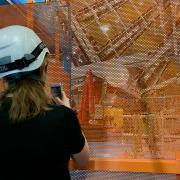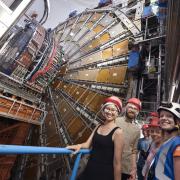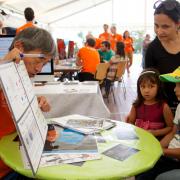Access to Collaboration Site and Physics Results

They say there’s no such thing as bad publicity, but how would recent attempts in a Hawaiian court to stop the opening of the LHC because of safety concerns affect the general public’s perception of CERN? The Open Day on 5-6 April gave the ATLAS Collaboration a chance to find out.
Despite – or perhaps because – of the court case, a record number of visitors came to CERN. A total of 76,000 people arrived at CERN over the weekend, 31,000 of whom went underground to view one or more of the experiments and the tunnel.
As expected, ATLAS was one of the most popular sites, with queues to visit the detector itself snaking out onto the street within half an hour of opening on each day. A total of 5,700 individuals were able to go underground - 2,200 friends and family of CERN staff on Saturday, and 3,500 members of the public on Sunday.
Planning how to get such huge numbers of people up and down the lift (elevator) shaft was the logistical nightmare assigned to Helfried Burckhart. “We had to arrange the whole circuit around the lift capacity,” he explained. “I calculated all this, but of course there are always uncertainties. You never know how fast the lift will be filled and emptied, but it turned out to be perfect. If you went from station to station, there were no bottlenecks - everything ran very smoothly between the different ATLAS stations. So the chain worked well. A lot of planning went into the weekend, of course, but we also had a lot of luck in that sense.”
A very efficient team of volunteers stood in front of the lift access area to hand out helmets. Each group went down with a different colour such that each group was easily identified. No time was wasted there and each set of helmets was counted, making sure nobody got lost.

“One of the most difficult things was trying to answer the visitor’s questions in a short and concise yet understandable way,” said ATLAS physicist and underground volunteer Tom Barber. When it was explained to one group how the trigger system in ATLAS rejects a large proportion of events so that only the few interesting ones would be recorded for analysis, one visitor asked concernedly if all these millions events would pile up and so contaminate the environment. The volunteers explained that the events, stored on computers across the world, pose no environmental threat.
Then there were the questions about the infamous court case. “The most common question I was asked was about the risk of black holes,” said Sofia Chouridou of the Santa Cruz Institute for Particle Physics at the University of California. Bertrand Brelier, a PhD student at the Université de Montréal and LPSC in Grenoble, and another Open Day volunteer, had a similar experience. “But we explained to the public that we have similar collisions in the high atmosphere of the Earth – we’re only reproducing conditions that exist already,” he said.
Louise Heelan, a PhD student at Carleton University, took a different approach to assuaging fears. “On the bus on my way to CERN on Sunday I got talking to a little boy and his mother,” she said. “He said to me: “I read in the New York Times that the probability that the LHC will produce a black hole is less than the probability that dragons will appear and eat the Earth.” And I thought – Wow! I’m totally going to use that quote for the rest of the day!”
Louise was surprised by the absence of protestors, given the recent news from Hawaii. Heidi Sandaker of the University of Bergen agreed. “People seemed calm and relaxed about the whole thing – they were far more interested in the physics behind the LHC.”
Friends, family, and the public weren’t the only visitors to the detector over the weekend. Peter Higgs – an Emeritus professor at the University of Edinburgh and the man for whom the Higgs boson is named – was guest of honour in the cavern, and journalists from all over the world came to take a look too. James Randerson from the science desk of UK national newspaper The Guardian described the LHC tour as “one of the most astonishing and mind-blowing sights of [my] journalistic career”.
“The idea that we will be creating conditions not seen since a fraction of a second after the big bang just blows my mind,” he added. “No wonder over 70,000 people came.”








